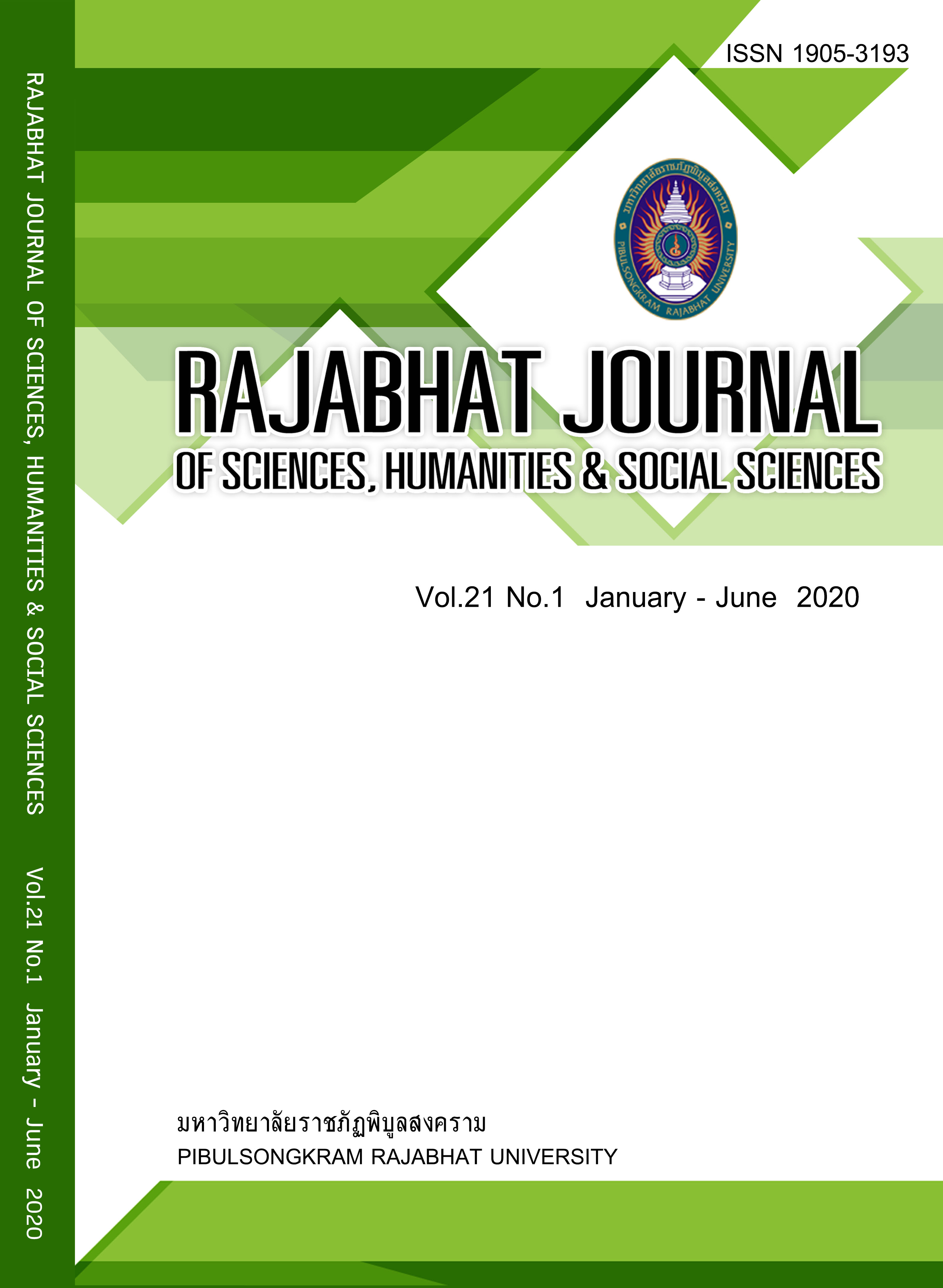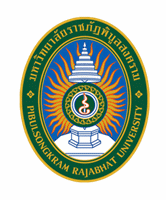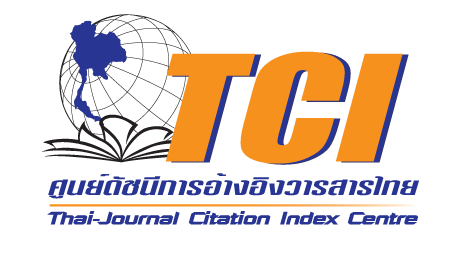ฤทธิ์ยับยั้งเชื้อแบคทีเรียและฤทธิ์ต้านอนุมูลอิสระ ของสารสกัดกอลล์จากหญ้าตดหมา
คำสำคัญ:
หญ้าตดหมา, สารสกัดกอลล์, ฤทธิ์ต้านอนุมูลอิสระ, ฤทธิ์ต้านเชื้อแบคทีเรียบทคัดย่อ
หญ้าตดหมา (Paederia pilifera Hook.f.) เป็นไม้เลื้อยเนื้ออ่อน ลำต้นสีเขียว ใบเดี่ยว อยู่ในวงศ์ Rubiaceae มีสรรพคุณช่วยระบบย่อยอาหาร แก้ไข้ แก้อาการท้องอืดท้องเฟ้อ หญ้าตดหมาบางต้นมีลักษณะบวมเป็นปุ่มปมคล้ายกับเนื้องอกที่เกิดจากการเจริญเติบโตของเนื้อเยื่อภายนอกโดยเฉพาะส่วนบริเวณกิ่งอ่อน เรียกว่า กอลล์ (gall) ในงานวิจัยนี้ได้มีการศึกษาการออกฤทธิ์ของสารสกัดกอลล์จากหญ้าตดหมาซึ่งเป็นองค์ความรู้ใหม่ที่ยังไม่เคยมีรายงานมาก่อน โดยการสกัดร้อน (Soxhlet extraction) ด้วยตัวทำละลายเฮกเซน ไดคลอโรมีเทน เอทิลอะซิเตต และเอทานอล ตามลำดับ ต่อการต้านอนุมูลอิสระด้วยวิธี 2,2-diphenyl-1-picrylhydrazyl (DPPH) และวิธี ferric reducing ability power (FRAP) พร้อมวิเคราะห์หาปริมาณสารประกอบฟีนอลิกทั้งหมด จากนั้นทดสอบความสามารถในการยับยั้งการเจริญของเชื้อแบคทีเรียที่ก่อให้เกิดโรค 2 ชนิด คือ Escherichia coli และ Staphylococcus aureus โดยวิธี paper disc diffusion แล้วทำการทดสอบต่อเพื่อหาค่าความเข้มข้นต่ำสุดที่ยับยั้งและฆ่าเชื้อแบคทีเรียได้ (ค่า MIC และ MBC) จากผลการทดลองพบว่าสารสกัดไดคลอโรมีเทนออกฤทธิ์ใน
การยับยั้งอนุมูลอิสระมีค่า IC50 เท่ากับ 2.05 มิลลิกรัมต่อมิลลิลิตร และมีความสามารถในการรีดิวส์สูงที่สุด ซึ่งมีค่า FRAP เท่ากับ 0.0397 มิลลิโมลสมมูลของ Fe2+ ต่อน้ำหนักสารสกัดหยาบ 1 กรัม และปริมาณสารประกอบฟีนอลิกทั้งหมดในสารสกัดไดคลอโรมีเทนมีค่าเท่ากับ 81.04±0.016 มิลลิกรัมของกรดแกลลิกต่อกรัมของสารสกัด นอกจากนี้ยังพบว่าสารสกัดไดคลอโรมีเทนและสารสกัดเฮกเซนออกฤทธิ์ในการยับยั้งเชื้อแบคทีเรีย Staphylococcus aureus โดยสารสกัดทั้งสองมีค่าความเข้มข้นต่ำสุดที่สามารถฆ่าเชื้อแบคทีเรีย (MBC) เท่ากับ 50 มิลลิกรัมต่อมิลลิลิตร จากผลการวิจัยนี้แสดงให้เห็นว่าสารสกัดไดคลอโรมีเทนและสารสกัดเฮกเซนจากกอลล์ของหญ้าตดหมานั้นมีศักยภาพที่สามารถพัฒนาเป็นสมุนไพรเสริมรักษาโรคที่ออกฤทธิ์ต้านเชื้อจุลินทรีย์ต่อไป
References
543-550.
Inta T, Saelee A, Sam-ang P. et al. Inhibition Staphylococcus aureus and antioxidant activity of crude extract from rested celosin (Celosia cristata), PSRU Journal of Science and Technology. 2019; 4(2): 34-42.
Pengkumsri N, Kantamul C, Towattanakit, P. et al. Antioxidative effect of alpinia conchigera rhizome extracts, Thai Pharmaceutical and Health Science Journal. 2011; 6(3): 195-201.
Ahmad MU, Islam MR, Huq E. et al. Chemical investigation of the aerial parts of Paederia foetida Linn, Journal of Bangladesh Academy of Science. 1991; 15: 19-22.
Basri DF, Fan SH. The potential of aqueous and acetone extracts of galls of Quercus infectoria as antibacterial agents, Indian Journal of Pharmacology. 2004; 37: 26-29.
Cheung S, Ninghon, L. Chinese medical herbs of Hong Kong, Commercial Press Hong Kong. 1985; 2: 160-161.
Fathabada A E, Shariatifar N, Mardania K. et al. Study on antibacterial and antioxidant activity of Oak gall (Quercus infectoria ) extracts from Iran, International Journal of Current Microbiology and Applied Sciences. 2015; 14: 44-50.
Ishikura N, Yang SQ, Yoshitama K. et al. Flavonol glycosides from Paederia scandens var. mairei. Zeitschrift für Naturforschung, C- A Journal of Bioscience. 1990; 45: 1081-1084.
Kapadia GL, Sharma SC, Tokuda H. et al. Inhibitory effect of iridoides on Epstein-Barr virus activation by a short-term in vitro assay of antitumor promoters, Cancer letters. 1996; 102: 223-226.
Kongkathip N, Kongkathip B, Savaspan K. et al. Composition and active compounds with inhibit Herpes simplex virus type 1 isolated from Paederia tomentos, Thailand Patent No. 106131. 2005.
Lippincott JA, Lippincott BB. The genus Agrobacterium and plant tumorigenesis, Annual review of Microbiology. 1975; 29: 377-405.
Nagesh L, Sivasamy S, Muralikrishna KS. et al. Antibacterial potential of gall extract of Quercus infectoria against Enterococcus faecalis an in vitro study, Pharmacognosy Journal. 2012; 4(30): 47-50.
Page MGP. The Role of the Outer Membrane of Gram-negative Bacteria in Antibiotic Resistance: Ajax’ Shield or Achilles’ Heel?. In: Coates A. (eds) Antibiotic Resistance. Berlin, Heidelberg: Handbook of experimental pharmacology vol 211 Springer; 2012.
Pham XS, Nguyen, VK, Le, TTH. Chemical composition and antibacterial effect of leaves of Paederia tomentosa L, Tap Chi Duoc Hoc. 1996; 11: 14-16.
Quang DN, Hashimoto T, Tanaka M. et al. Iridoid glucosides from roots of Vietnamese Paederia scandens, Phytochemistry. 2002; 60: 505-514.
Saelee W, Srisayam M, Phalee W. et al. Effect of egg woman (Phyllanthus spp.) crude extracts on inhibition of Staphylococcus aureus, Proceedings of 4th Pibulsongkramvijai. 2018; 331-338.
Shankara BR, Ramachandra YL, Rajan, SS. et al. In vitro antibacterial activity of Terminalia chebula leaf gall extracts against some human pathogenic strains, International Current Pharmaceutical Journal, 2012; 1(8): 217-220.
Tongpenyai A. Extraction, isolation and biological testing and biological testing for antiviral [Herpes simplex (HSV-1)] constituents from Paederia tomentosa, Junior Science Talent Project National Center for Genetic Engineering and Biotechnology Bangkok Thailand 31. 2001.
Tran NN. Gop phan vao viec thong ke nhung loai thuc vat coich thuoc ho caphe (Rubiaceae Juss) o Vietnam (Contribution to the enumeration of useful species of the family Rubiaceae juss in Vietnam), Journal of Biology. 1987; 9: 40-44.
Vanga S, Pingili M, Tharigoppula S. Phytochemical screening and evaluation of antifungal activity of gall extracts of Quercus infectoria, International Journal pharmaceutical sciences and research, 2017; 8(7): 3010-3013.
Wang Y, Huang T. Screening of anti-helicobacter pylori herbs deriving from Taiwanese folk medicinal plants, FEMS immunology and medical microbiology. 2005; 43: 295-300.
Wagner WL, Herbst DR, Sohmer SH. A manual of the flowering plants of Hawaii, New Zealand Journal of Botany. 1992; 30: 119-120.
Downloads
เผยแพร่แล้ว
How to Cite
ฉบับ
บท
License
Each article is copyrighted © by its author(s) and is published under license from the author(s).









